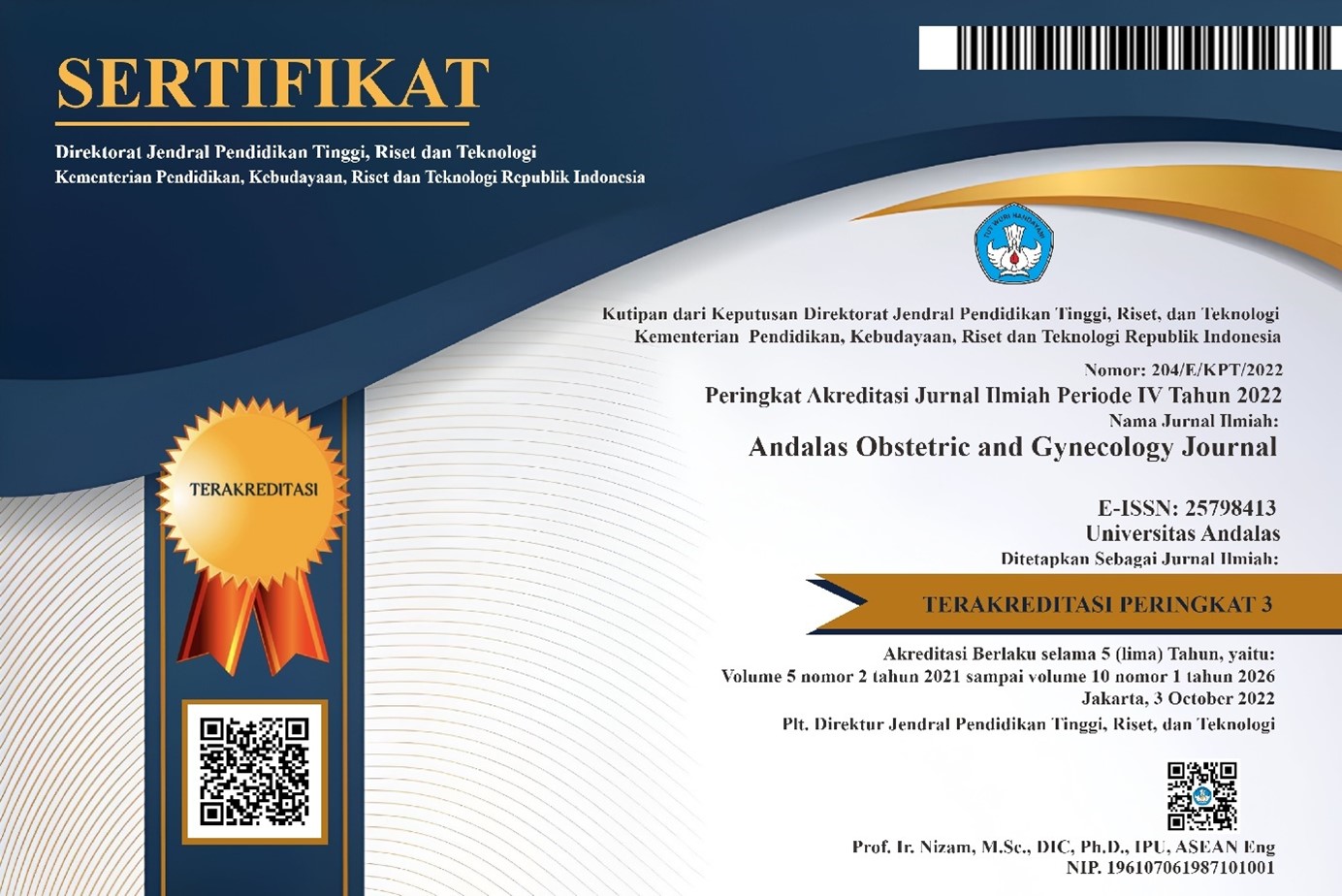Comparison of Pain Scale in Patients with Endometriosis Cysts and Adenomyosis Before Surgery, After Surgery and After Giving Analog GNRH
DOI:
https://doi.org/10.25077/aoj.4.1.35-47.2020Abstract
Background: Endometriosis is the growth of the epithelium and endometrial glands outside the uterine cavity. In endometriosis there is a process of neurogenesis and angiogenesis. The degree of endometriosis pain depends on the depth of endometrial implant infiltration in nerve fibers and / or neurogenesis. Operative action and postoperative hormone therapy are the main choices for preventing recurrence and reducing pain complaints.
Purpose: to determine the comparison of pain scales of patients with endometriosis before surgery, after surgery and after administration of GnRH analogues.
Method: This study was an observational analytic with a retrospective cohort design in the Obstetrics and Gynecology Clinic of RSUP Dr. M. Djamil Padang in June 2017 to January 2018. The sample size were of 35 people with inclusion and exclusion criteria. The inclusion criteria were the diagnosis of endometriosis (endometriosis cysts and adenomyosis) from ultrasonography and anatomical pathology, had surgery and received analogue GnRH injection three times. Exclusion criteria were not proven endometriosis, hysterectomy surgery, using analgesics and not following analogue GnRH injection procedures. The pain scale is assessed by the Wong-Baker Faces Pain Rating Scale. The pain scale is assessed during menstruation before surgery, first menstruation after surgery and first menstruation after three analogues of GnRH injections. Data analysis using SPSS version 22, where univariate analysis is used to see the characteristics of respondents and bivariate analysis using Wilcoxon Test. Statistical test results were significant if p <0.05.
Result: Based on the Wilcoxon statistical test results obtained p value = 0.0001 (p value <0.05) which can be concluded that there is a significant reduction in the pain of endometriosis of patients after surgery compared to before surgery.
Conclusion: There was a significant decrease in pain in endometriosis patients before surgery.
Keywords: Endometriosis, Adenomyosis, Pain Scale, GnRH anaologistReferences
Farguhar C. Endometriosis. BMJ : British Medical Journal. 2007;334: 249-53.
Rolf, Treede D. The International Association for the Study of Pain definition of pain: as valid in 2018 as in 1979, but in need of regularly updated footnotes. Department of Neurophysiology, Center for Biomedicine and Medical Technology Mannheim, Heidelberg University, Mannheim, Germany.2018;1-3
Vercellini P. Fedele L. Pietropaolo G. Consonni D. Crosignani P. Association between endometriosis stage, lesion type, patient characteristics and severity of pelvic pain symptoms: a multivariate analysis of over 1000 patients. Human Reproduction.2007;266-71.
Jones K. Sutton C. Laparoscopic management of ovarian endometriomas: a critical review of current practice. Curr Opin Obstet Gynecol.2000 ;12:309-15.
Jacobson T. Duffy J. Barlow D. Koninckx P. Garry R. Laparoscopic surgery for pelvic pain associated with endometriosis. Cochrane Database Syst Re. 2009;4:1-21
Bloski T. Pierson R. Endometriosis and Chronic Pelvic Pain: Unraveling the Mystery Behind this Complex Condition: Nursing for women's health. 2008;12:382-95.
Yap C. Furness S. Farquhar C. Pre and post operative medical therapy for endometriosis surgery. Cochrane Database Syst Rev.2004;3:1-56
Busacca M. Marana R. Caruana P. Candiani M. Muzii L. Calia C. Bianchi S. Recurrence of ovarian endometrioma after laparoscopic excision. Am J Obstet Gynecol .1999;180(3):519-23
Porpora MG. Pallante D. Ferro A. Crisafi B. Bellati F. Panici PB. Pain and ovarian endometrioma recurrence after laparoscopic treatment of endometriosis: a long-term prospective study.2010;93:716-21.
Herr KA. Garand L. Assessment and measurement of pain in older adults. Clinics in geriatric medicine. 2001;17:457-73
Booker SQ. Haedtke C. Controlling pain and discomfort. Part 1: Assessment in Verbal Older Adults. Nursing.2016;46:65-8.
Aziato L. Dedey F. Marfo K. Asamani JA. Clegg Lamptey JNA. Validation of three pain scales among adult postoperative patients in Ghana. BMC Nursing. 2015;14:42-51
Anaf V. Chapron C. Nakedi IE. Moor VD. Simonart T. Noel J. Pain, mast cells, and nerves in peritoneal, ovarian, and deep infiltrating endometriosis. Fertil Steril. 2006;86:1336-43.
Tulandi BAS, Prospective study of intraabdominal adhesion among women of different races with or without keloids. Am J Obset Gynecol. 2011; 204:132-6
Vercellini P.Trespid L. Giorgi OD. Cortesi I. Parazzini F. Crosignani P. Endometriosis and pelvic pain: relation to disease stage and localization. Fertil Steril. 1996;65:299-304.
Tokushige N. Markham R. Russell P. Fraser I. Nerve fibres in peritoneal endometriosis. Hum Reprod Update. 2006;21:3001-7.
Eshre. Management of women with endometriosis. Guideline of The European Society of Human Reproduction and Embriology;2013:5-95
Batzer F. GnRH analogs : options for endometriosis-associated pain treatment. Journal of minimally invasive gynecology.2006;13:539-45.
Brown J. Pan A. Hart R. Gonadotropin-releasing hormone analogues for pain associated with endometriosis. Cochrane database of systematic reviews. 2010;12:1-115
Rcog. The investigation and management of endometriosis. Green-top Guidelines. 2008;24:1-14
Downloads
Published
Issue
Section
License
Copyright (c) 2020 Andalas Obstetrics And Gynecology Journal

This work is licensed under a Creative Commons Attribution 4.0 International License.
Copyright
Authors who publish with this journal agree to the following terms:
- Authors retain the copyright of published articles and grant the journal right of first publication with the work simultaneously licensed under a Creative Commons Attribution 4.0 International License that allows others to share the work with an acknowledgment of the work's authorship and initial publication in this journal.
- Authors are able to enter into separate, additional contractual arrangements for the non-exclusive distribution of the journal's published version of the work (e.g., post it to an institutional repository or publish it in a book), with an acknowledgment of its initial publication in this journal.
- Authors are permitted and encouraged to post their work online (e.g., in institutional repositories or on their website) prior to and during the submission process, as it can lead to productive exchanges, as well as earlier and greater citation of published work (See The Effect of Open Access).
License:
Andalas Obstetrics and Gynecology Journal (AOJ) is published under the terms of the Creative Commons Attribution 4.0 International License. This license permits anyone to copy and redistribute this material in any form or format, compose, modify, and make derivatives of this material for any purpose, including commercial purposes, as long as they credit the author for the original work.







